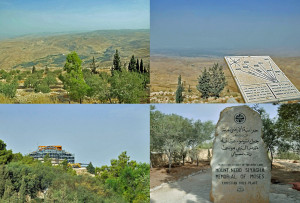According to Deuteronomy, after Moses had led the Israelites in the wilderness for 40 years, he viewed the Promised Land from atop “Mt. Nebo,” but God would not permit him enter. He died and was buried “in Moab, in the valley opposite Beth Peor, but to this day no one knows where his grave is.”
After Emperor Constantine legalized Christianity in 313 A.D., Christians eager to identify Biblical sites were undeterred by the lost knowledge of Mt. Nebo’s location and the statement that Moses was buried in “the valley.” Pilgrims located Moses’ tomb on a mountain peak providing a spectacular view of the Jordan Valley and built a basilica on the peak now called “Siyagha.” The church and its empty tomb became popular among pilgrims and were described in 394 by a visiting nun named Egeria. A mosaic floor added to the church in 531 was covered when the church was rebuilt in 597. The site was eventually abandoned and forgotten.
In the 1930s, the Jordanian mountain peak claimed by early Christians to hold Moses’ tomb was excavated. Franciscans built a modern church built over the recovered mosaics of the earlier church and erected a stone honoring Moses. A sign overlooking the Jordan Valley points to important cities in Israel and Palestine. The nearest of those cities is Jericho, near where an Islamic tradition places the grave of Moses.
The Franciscan church protecting the sixth century mosaics is closed for restoration. But on a clear day, the view of Biblical cities from above provides a worthwhile mountain top experience even if the location of Moses’ tomb remains unknown.
